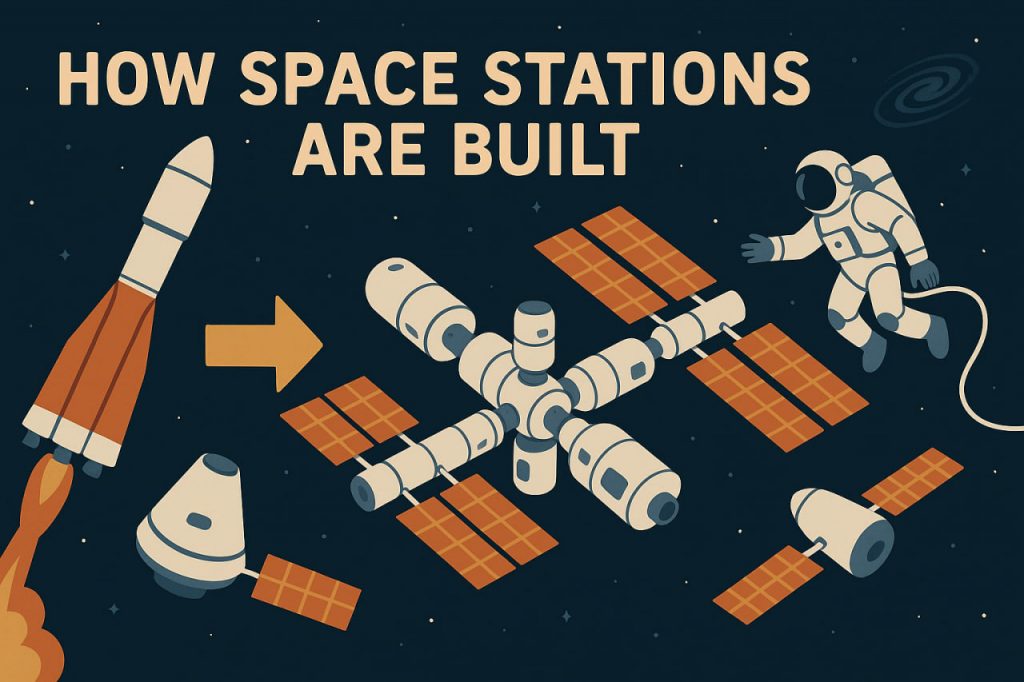A space station is a large, habitable artificial satellite that orbits Earth, serving as a platform for scientific research, space exploration, and international cooperation. Building a space station is one of the most complex engineering tasks ever undertaken by humanity. Unlike ground-based structures, space stations must be assembled in orbit, piece by piece, using specially designed modules, spacecraft, and astronaut labor.
The construction of space stations such as Mir, Skylab, and the International Space Station (ISS) has revolutionized how humans live and work in space.
Design and Planning
The process begins with years (or decades) of planning. Engineers must account for:
- Modular design, allowing gradual construction in space
- Life support systems to provide oxygen, water, and food
- Radiation shielding and thermal control
- Power systems, often using large solar arrays
- Docking ports for spacecraft and future modules
The ISS, for example, was designed as a multinational project, with contributions from NASA, Roscosmos, ESA, JAXA, and CSA.
Manufacturing the Modules
Space station modules are built on Earth in specialized aerospace facilities. These modules are:
- Pressurized, allowing astronauts to live inside without spacesuits
- Outfitted with equipment, computers, and connectors for power and data
- Tested extensively for strength, leaks, and compatibility
Examples of modules include laboratories, crew quarters, airlocks, and solar panel trusses.
Launching Into Orbit
Modules are too large to be sent all at once. Instead, they are launched one at a time using:
- Rockets like the Space Shuttle, Proton, or Falcon 9
- Cargo spacecraft such as Dragon, Progress, and Cygnus
- Launch windows must be calculated precisely to reach the correct orbital trajectory
Some modules are self-powered and automatically dock, while others require manual docking by astronauts or robotic arms.
Orbital Assembly
Once in space, modules are assembled during spacewalks (EVAs) and using robotic arms like Canadarm2. Astronauts connect power cables, fluid lines, and secure the modules.
This phase requires extreme precision due to:
- Microgravity conditions
- Limited space and mobility
- Harsh temperature extremes
On the ISS, assembly took over 13 years with contributions from 15 nations.
Power, Communication, and Life Support
After assembly, systems must be connected and activated:
- Solar panels provide electricity
- Batteries store energy for night-time use
- Antennas enable communication with ground control
- Environmental control systems recycle air and water
Everything must work redundantly to protect the crew from any failure.
Expanding and Upgrading
Space stations are not static. Over time, new modules are added, and old ones are replaced. Upgrades may include:
- More powerful computers
- New research labs
- Docking ports for commercial missions
- Expansion for space tourism or lunar gateway projects
This modular approach allows the station to evolve with technology and scientific goals.
Glossary
- Space station – a habitable satellite that orbits Earth and supports long-term missions
- Modular design – building with separate components that fit together
- EVA (Extravehicular Activity) – spacewalk performed by astronauts
- Docking – the connection of two spacecraft or modules
- Solar arrays – panels that convert sunlight into electricity
- Life support system – technology that maintains breathable air, water, and temperature


